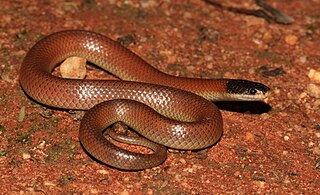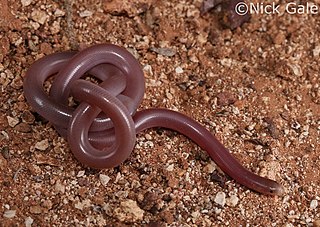
The eastern brown snake, often referred to as the common brown snake, is a species of highly venomous snake in the family Elapidae. The species is native to eastern and central Australia and southern New Guinea. It was first described by André Marie Constant Duméril, Gabriel Bibron, and Auguste Duméril in 1854. The adult eastern brown snake has a slender build and can grow to 2 m (7 ft) in length. The colour of its surface ranges from pale brown to black, while its underside is pale cream-yellow, often with orange or grey splotches. The eastern brown snake is found in most habitats except dense forests, often in farmland and on the outskirts of urban areas, as such places are populated by its main prey, the house mouse. The species is oviparous. The International Union for Conservation of Nature classifies the snake as a least-concern species, though its status in New Guinea is unclear.
Anomalopus mackayi, commonly known as the five-clawed worm skink, long-legged worm skink, and MacKay's burrowing skink, is a species of smooth-scaled burrowing skink, a lizard in the family Scincidae. The species is endemic to eastern Australia.
Dunmall's snake is a species of venomous snake in the family Elapidae. The species is endemic to Australia.

Dwyer's snake also known commonly as the whip snake and the variable black-naped snake, is a species of venomous snake in the family Elapidae. The species is endemic to Australia, where it is found from New South Wales to South Queensland. While closely related to Australian sea snakes, S. dwyeri is a terrestrial reptile.

The yellow-faced whip snake is a species of venomous snake in the family Elapidae, a family containing many dangerous snakes. D. psammophis is endemic to Australia, found throughout the continent in a variety of habitats from coastal fringes to interior arid scrubland.

Morethia boulengeri is a species of lizard in the family Scincidae. The species is endemic to Australia.

The common scaly-foot is a widespread species of legless lizard in the Pygopodidae family. It is endemic to Australia.

The prong-snouted blind snake is a species of non-venomous worm-like burrowing snakes belonging to the Typhlopidae family. It is endemic to central southern, continental Australia.

Anilios endoterus is commonly known as the interior blind snake. It is one of 42 species of snake in the genus Anilios (Ramphotyphlops) from the Typhlopidae family living in Australia. These snakes appear to be blind, having vestigial eyes that are extremely sensitive to light. It is a cryptic burrowing snake that lives in tunnels underground, living mainly on a diet of ants. They are found in arid and semi-arid desert regions of central Australia and are considered endangered in New South Wales (NSW).

Diplodactylus vittatus, commonly known as the eastern stone gecko, stone gecko, and wood gecko, is a species of diplodactylid lizards that occurs in forest, shrubland and arid regions across Australia. It is widespread across the states of Queensland, Victoria and New South Wales, commonly found in dry peripheral bushlands. This gecko can be kept as a pet or seen within zoo enclosures.

The golden-crowned snake is a small species of venomous snake in the family Elapidae. The species is endemic to Australia.
Hemiaspis damelii is a species of venomous snake in the family Elapidae. It is a relatively small species of elapid with a mean snout-vent length (SVL) of 42.6 to 60 cm. The species is endemic to eastern Australia and is most commonly found across central inland New South Wales through to the interior of south-eastern Queensland. Common names for this species include grey snake and Dämel's Snake. The specific name, damelii, is in honor of German entomologist Edward Dämel, who collected Australian specimens for Museum Godeffroy.

Stephens's banded snake is a species of highly venomous tree snake in the family Elapidae. The species is endemic to Australia.

The ringed brown snake is a species of venomous elapid snake native to a broad swathe of inland Australia, from western New South Wales and Queensland to Western Australia.
The yellow-naped snake, also known commonly as Barnard's snake, is a small species of venomous snake in the family Elapidae. The species is native to northeastern Australia.
The eastern hooded scaly-foot or eastern scaly-foot is a species of flap-footed lizard found in the complex heaths of the lower west coast and the spinifex grasslands of mainland Australia. They are popular pets and are often mistaken for snakes due to their limbless appearance.

Neelaps calonotos, also known commonly as the black-striped burrowing snake, the black-striped snake, and the western black-striped snake, is a species of mildly venomous burrowing snake endemic to Australia. The specific epithet calonotos ("beautiful-backed") refers to the patterning on the upper surface of the body.
The saltbush slender bluetongue is a species of lizard in the family Scincidae. The species is endemic to the arid interior of eastern Australia. Although its conservation status is of least concern, it has been listed as endangered in New South Wales. The slender saltbush bluetongue has been recorded in Sturt National Park in New South Wales but extends into northeast South Australia and south-west Queensland.
Cryptoblepharus pannosus, also known commonly as the ragged snake-eyed skink, is a species of lizard in the family Scincidae. The species is endemic to Australia.
Ctenotus spaldingi is a diurnal terrestrial skink (Scincidae) species of lizard, commonly known as the straight-browed ctenotus or Spalding’s ctenotus. Native to Australia the species is found in the northern areas of Australia, along the east coast, in the north and east of South Australia and throughout Victoria and in southern Papua New Guinea. Their conservation status is of least concern classified by the IUCN. Individuals can be up to 30cm long from the snout to tail or 10cm long from the snout to vent (SVL). They typically inhabit grasslands and low vegetation in savannah woodlands in coastal dune areas, monsoon scrub and woodland commonly found around rock outcrops and when disturbed will hide in shallow burrows or amongst ground litter.












